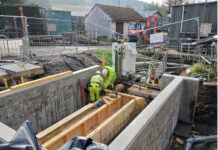THE Scottish Environment Protection Agency has been on the road to unveil a new registration category.
It has been in discussions with farmers and landowners on land drainage and watercourse management issues at a series of forums hosted by the National Farmers Union Scotland.
Agency staff provided details of the newest registration which will apply to already straightened watercourses that are less than five metres wide at the base of the channel. That activity previously required a more expensive licence application but the new registration is said to offer a cheaper and more efficient process for farmers who want to dredge in rivers that have historically been subject to maintenance works. They will also provide examples of situations where neighbouring farmers have cooperated to apply jointly for a licence, so cutting costs and ensuring whole catchment consideration of the issue.
David Harley, SEPA’s water and land manager, said: “SEPA understands that land managers have faced very challenging conditions during the recent, and unusually wet, weather and will want to ensure that drainage systems work. Field drainage is a complex issue and the condition of soils, sub-surface field drains and drainage ditches are all important and related factors.
“The dredging of burns and watercourses in the wrong place and in the wrong way can cause serious environmental harm in the stretch of river being worked. It can also result in pollution, damage to fisheries and increased flooding downstream. However, SEPA does not block all forms of dredging activity and wants to work with farmers to ensure that appropriate work can be carried out whilst minimising environmental impact.”
To clarify current requirements and update recent changes, SEPA gave a series of presentations from Inverness to Castle Douglas.
Where farmers want to dredge watercourses that have been subject to historic maintenance and are greater than a metre wide, SEPA is introducing a new registration level category. It will apply to already straightened watercourses less than five metres wide at the base of the channel and there will be associated good practice requirements. The activity previously required a more expensive application.
For extensive works in more natural rivers, a formal licence may still be required. In such situations SEPA wants to encourage landowners and farmers to cooperate with neighbours to apply jointly.
A successful example of this joint working is in Dumfries where the first catchment scale licence for sediment management has been issued for the River Ae, and discussions are underway in several other catchments around the country. An agency spokesman said: “SEPA’s belief is that taking this sort of co-operative approach and considering the issue at a catchment scale is the way forward.”
SEPA does not require an application to authorise activities such as:
· removal of in-stream or bank-side vegetation.
· removal of in-stream debris/rubbish
· construction of new drains and ditches (where no watercourse previously existed)
· construction and maintenance of road drains










